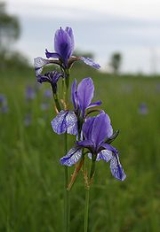
Iris sibirica
Encyclopedia
Iris sibirica, the Siberian Iris, is a flowering plant
in the genus Iris
, native to northern Asia
and eastern and central Europe
.
It is a herbaceous
perennial plant
growing to 50-120 cm tall. The leaves
are glaucous green, narrow and fairly rigid, blade-shaped, 40-80 cm long and 2-4 cm broad. The flower
s are typical of an iris, borne in late spring or early summer on unbranched or sparsely-branched stems held above the leaves, each flower 4-7 cm diameter, mid- to purple-blue, often with a paler whitish or yellowish centre.
s in temperate regions around the world. It is the parent plant of many hybrids, used because of its attractive foliage and ability to flourish in a wide range of climates; the hybrids vary widely in flower colour.
Iris sibirica Cultivar
s
Flowering plant
The flowering plants , also known as Angiospermae or Magnoliophyta, are the most diverse group of land plants. Angiosperms are seed-producing plants like the gymnosperms and can be distinguished from the gymnosperms by a series of synapomorphies...
in the genus Iris
Iris (plant)
Iris is a genus of 260-300species of flowering plants with showy flowers. It takes its name from the Greek word for a rainbow, referring to the wide variety of flower colors found among the many species...
, native to northern Asia
Asia
Asia is the world's largest and most populous continent, located primarily in the eastern and northern hemispheres. It covers 8.7% of the Earth's total surface area and with approximately 3.879 billion people, it hosts 60% of the world's current human population...
and eastern and central Europe
Europe
Europe is, by convention, one of the world's seven continents. Comprising the westernmost peninsula of Eurasia, Europe is generally 'divided' from Asia to its east by the watershed divides of the Ural and Caucasus Mountains, the Ural River, the Caspian and Black Seas, and the waterways connecting...
.
It is a herbaceous
Herbaceous
A herbaceous plant is a plant that has leaves and stems that die down at the end of the growing season to the soil level. They have no persistent woody stem above ground...
perennial plant
Perennial plant
A perennial plant or simply perennial is a plant that lives for more than two years. The term is often used to differentiate a plant from shorter lived annuals and biennials. The term is sometimes misused by commercial gardeners or horticulturalists to describe only herbaceous perennials...
growing to 50-120 cm tall. The leaves
Leaf
A leaf is an organ of a vascular plant, as defined in botanical terms, and in particular in plant morphology. Foliage is a mass noun that refers to leaves as a feature of plants....
are glaucous green, narrow and fairly rigid, blade-shaped, 40-80 cm long and 2-4 cm broad. The flower
Flower
A flower, sometimes known as a bloom or blossom, is the reproductive structure found in flowering plants . The biological function of a flower is to effect reproduction, usually by providing a mechanism for the union of sperm with eggs...
s are typical of an iris, borne in late spring or early summer on unbranched or sparsely-branched stems held above the leaves, each flower 4-7 cm diameter, mid- to purple-blue, often with a paler whitish or yellowish centre.
Cultivation and uses
Iris sibirica is widely grown in gardenGarden
A garden is a planned space, usually outdoors, set aside for the display, cultivation, and enjoyment of plants and other forms of nature. The garden can incorporate both natural and man-made materials. The most common form today is known as a residential garden, but the term garden has...
s in temperate regions around the world. It is the parent plant of many hybrids, used because of its attractive foliage and ability to flourish in a wide range of climates; the hybrids vary widely in flower colour.
Iris sibirica Cultivar
Cultivar
A cultivar'Cultivar has two meanings as explained under Formal definition. When used in reference to a taxon, the word does not apply to an individual plant but to all those plants sharing the unique characteristics that define the cultivar. is a plant or group of plants selected for desirable...
s

